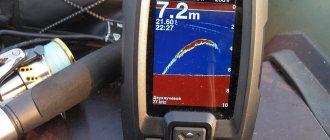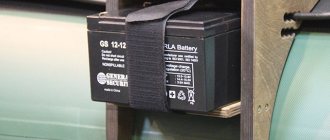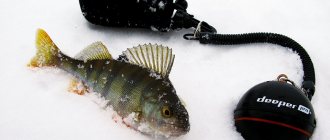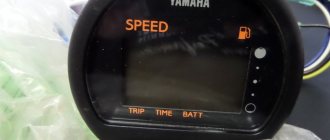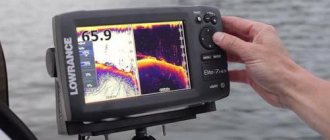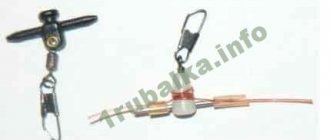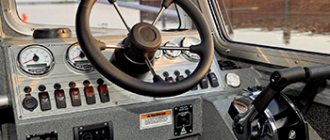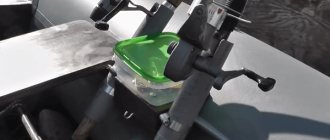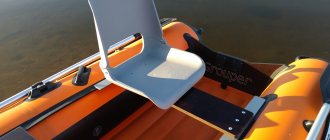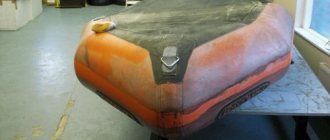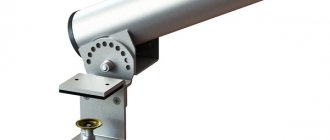The echo sounder was created for ships, helping to avoid shallow water and underwater obstacles. But with the development of microelectronics, it became possible to create compact devices for fishing enthusiasts. Modern products can show the bottom topography, depth, water temperature and even schools of fish.
Since an echo sounder is not a cheap product, let’s figure out why a fisherman needs it. So:
- Determines the depth. Large specimens are always near the bottom, so choosing the right spinning rod parameters or choosing the optimal bait weight is the key to successful fishing;
- Shows the bottom topography. This is especially important when catching predatory representatives of a reservoir. Knowing the habits of a fish, you can quickly determine its habitat;
- Indicates the places of accumulation and the size of the fish. This makes choosing the optimal place for casting much easier;
- Temperature and atmospheric conditions are constantly monitored. The activity of underwater inhabitants mainly depends on these factors;
- GPS function. It is especially helpful when traveling to a large body of water. The successful location is marked and the device saves the coordinates.
Echo sounder installation location
A good PVC boat is indispensable for fishing, but an echo sounder requires several conditions to be met to obtain adequate readings:
- The transom is the most commonly used mounting location on all types of PVC boats
The signal from the sensor (transducer) is perpendicular to the water surface. This is the only way to achieve the correct bottom picture;
- The absence of air bubbles under water near the sensor as a result of turbulence when the boat moves;
- Eliminates even slight transducer vibration.
Based on these features, three main locations for mounting the sensor are recommended:
- Transom. This is the most commonly used mounting location on all types of PVC boats. This ensures the necessary rigidity and the ability to adjust the position using factory or homemade fasteners;
- Bottom of the boat. Another common method to achieve correct readings. Glue or suction cups are used, often included with the device;
- Remote method. In the absence of a transom or constantly changing swimming equipment, you can use a plastic bottle, which will allow you to place the product perpendicular to the water. The immersion depth can be adjusted by adding or removing liquid from the bottle.
The echo sounder screen itself is most often attached:
- A bench in a convenient location. This could be a bracket, a suction cup, or glue. Each is determined independently;
- Bottom or side surface. The fastening methods are almost the same - glue or suction cup.
Peculiarities
What is an echo sounder and what is it used for? This is a compact hydroacoustic station that allows you to obtain information about what is happening in the water under the fisherman’s nose. It’s not easy to look underwater with a simple eye, but an echo sounder allows you to see what’s happening right on the screen, fixed in a convenient place.
The principle of operation is that the echo sounder emits very short sounds, after which it “listens” to the reflections of sounds from surrounding objects. On land, bats navigate in a similar way, and under water, creatures such as whales and dolphins. The fundamental feature of an underwater echo sounder is that its key element (the emitter and also the signal sensor) must be placed under water.
The air-water interface perfectly reflects sound in both directions, making it impossible to “see” anything from above.
On commercial vessels, echo sounders are usually placed in special slide-out containers. On military submarines, a sonar station can occupy an entire compartment, and its sensors are located along the entire hull of the submarine. How do inexpensive devices suitable for use in recreational fishing work? And how to attach such a useful device to a small boat? On ships with a metal hull, the location of acoustic locators is determined at the design stage. Typically, echo sounders are placed in separate small housings attached to the outside of the ship's hull. Some ships have special compartments in which part of the hull is not made of metal and is constantly flooded with water.
Why such difficulties? The peculiarity of an echo sounder is that it “sees sound”. Sound waves do not travel well through metal and are easily reflected from the air-water interface. Therefore, the sensor must be placed directly in the water, but in such a way that it does not create unnecessary resistance to the movement of the vessel.
Having decided to equip a simple inflatable boat with an echo sounder, a fisherman is faced with a lot of technical problems. Some of them are caused by the fact that inexpensive echo sounders are made in a very specific way and require precise placement. Another important feature is that the rubber boat cannot simply be drilled anywhere. The main module can be placed in almost any convenient place. As a rule, there is a space for this on the dashboard next to the steering column and the box with fishing tackle. An example of such placement is shown in Fig. 1.
The echo sounder sensor must be mounted on a PVC boat using external mechanical brackets. This complicates the design, but leaves the possibility of compact assembly and storage of the boat. The main thing is that using installation in the form of a special bracket, you can choose the location of the sensor at will. Boats with NDND have a special design. This abbreviation codes for the term "low pressure inflatable bottom".
This design has good seaworthiness and provides comfort. But if in a small inflatable boat you can try to make a cutout in the bottom and firmly glue in the echo sounder sensor, then in a boat with NDND the situation becomes more complicated.
Echo sounder mount
Each device is equipped with a fastening system; in addition, you can choose the fasteners for yourself; they are available for sale separately. But our people are not used to entrusting important matters to manufacturers, so there are several options for self-production.
Factory method
The most common mount is the option of rigid installation on the transom using the following devices:
- Clamp. Usually made of stainless material with a rubber layer, which allows the product to be tightly and reliably fastened to the hard surface of the boat;
- Bracket. A tube that makes it possible to adjust the sensor in depth, and in expensive models, the angle of rotation;
- Mounting unit for transducer. This device presses the sensor to the bracket.
Operating procedure:
- The clamp is pressed tightly against the transom. If there is an engine, the position of the product is selected so as to eliminate inconvenience during maneuvering. The mounting location is usually moved to the right or left closer to the side;
- The sensor is rigidly attached to the bracket and lowered to the required depth;
- is pressed against the clamp using a special bolt
- Adjustments are made to the depth and angle to the surface. To do this, the clamp on the clamp is slightly released and the bracket moves in the required direction. After this, the entire structure is rigidly fixed.
- The echo sounder screen is placed on the bench or bottom. An option with a suction cup on the rubber side is possible.
Advantages:
- Possibility of quick installation and dismantling. This is important for a PVC boat, since it is usually deflated and folded after finishing fishing;
- Reliability of fastening , correct location of the sensor, easy adjustment.
Flaws:
- relatively high price;
- the rigidity of the structure can lead to serious damage to the transom when hitting an obstacle, so the boat must be operated with extreme caution.
The bracket is pressed against the clamp using a special bolt
Homemade mount
Option 1
It is much cheaper to make the structure yourself. For this you will need:
- An ordinary metal-plastic pipe is about a meter long;
- A tube made of stainless material, the diameter of which will be slightly larger than the metal-plastic one;
- Clamp. Easily found in hardware stores;
- Bolts with washers, rubber gaskets (you can use old bicycle inner tubes), clamps, cotter pin.
Procedure:
- Using clamps and gaskets, we attach a metal pipe about 0.4 meters long to the clamp;
- We insert metal-plastic inside, the lower end of which is flattened. We drill 2 holes for mounting the sensor using bolts and nuts. The use of washers is mandatory;
- The transducer is fixed , and the wire from it is passed inside the pipe;
- The clamp is placed in its place (transom), and the length of the metal-plastic pipe is adjusted using a cotter pin and pre-drilled holes;
- to the end of the metal-plastic protruding at the top in any convenient way.
Option 2
This method is suitable for people who constantly use the same boat
Another way to mount the sensor once and for all is to glue it into the housing. How it's done:
- Near the keel, all layers on the bottom are removed, right down to the outer layer;
- Using epoxy glue, the sensor is glued to the surface. The small thickness of the rubber cannot interfere with the normal operation of the transducer;
- The remaining space from the cutout is filled with the same composition.
This method is suitable for people who constantly use the same boat, and if stored rolled up, there will be no harm to the sensor.
Option 3
Removing the sensor outside the watercraft. Simple instructions:
- The transducer is attached with adhesive tape or tape to the middle of a plastic bottle with a volume of 0.5 to liter;
- the wire from the sensor is secured to the neck using the same means;
- the screen is placed on the bench, a wire is connected to it;
- Water is poured into the bottle until the required immersion depth of the sensor is reached.
Suitable for reservoirs without current or creeks.
Don't have a fish finder? Garmin Striker Plus 4CV Editor's Choice
The Garmin STRIKER PLUS 4CV fish finder has won many international awards. He received an award at CES 2021, won at the European fishing exhibition EFTEX 2021 and the Asian China Fish 2021 Deeper. The smart fish finder has been named an Editor's Choice by Fish Alaska, Anglers Mail and PC Magazine.
- For fishing at any time of the year and in any conditions.
- Creates a map of a body of water in the built-in Garmin Quickdraw Contours program.
- High accuracy of showing the depth of the reservoir and the location of the fish (its size, depth).
- Emits a beep when a fish is detected.
| Clear CHIRP ClearVü scanning sonar images. The STRIKER Plus 4cv fishfinder includes Garmin CHIRP technology that, when combined with Garmin ClearVü scanning sonar, provides nearly photographic images of what's beneath your boat. You will get a clear picture of underwater terrain, objects and fish. Traditional Garmin CHIRP sonar provides excellent target separation. Thus, this transducer will help you catch more fish. |
| Garmin Quickdraw Contours program. No one knows a body of water better than the one who fishes in it. While you cruise the shores and deep waters, Quickdraw Contours creates HD fishing maps for the areas you've visited. Users do not require special knowledge. The STRIKER Plus 4CV can store up to 2 million acres of Quickdraw Contours maps with 30cm contours. |
Buy on the official website with delivery. Price 5800 rub. There are seasonal discounts .
Sensor holders
The installation location of the sensor depends on the characteristics of the boat. It must be located so that its operation is not affected by flow disturbances arising from the operation of the propeller. The active surface of the transducer must be directed vertically downward in any mode of boat movement. Otherwise, the measurement results will be unreliable.
The fastening of the holder must ensure quick installation and installation of the sensor in the working position when the boat is on the water. The design must provide protection for the transducer from being caught or hit by a foreign object. Rigid fixation of the sensor fastening elements can lead to its detachment or damage.
Factory
The industry produces echo sounders with several mounting options:
- on clamps;
- on suction cups;
- on glue and other fasteners (non-removable);
- floating.
All types of fastening must meet the established criteria:
- reliability;
- protection from snags and impacts against foreign objects;
- possibility of adjusting the depth and angle of deviation from the transom.
In most cases, manufacturers use anti-corrosion materials for fastening elements. To protect the transducer from destruction, spring-loaded brackets are installed that can deflect when caught or hit. To mount echo sounders on high-speed vessels, the sensors are placed in fairings. This helps reduce hydraulic resistance and reduce the load on it.
Transom mount
Holders attached to clamps are very popular among fishermen. In this way, you can install the sensor on both a stationary and removable transom of a floating craft. This mount is especially widely used by owners of inflatable boats. In addition to simple and quick installation, it makes it possible to adjust the transducer rod in height and change its inclination relative to the transom. This is of great importance when moving and planning the boat.
Mounting kit includes:
- clamp;
- bracket;
- emitter installation mechanism.
To prevent spontaneous lowering of the sensor, the bracket is fixed with a screw stopper. The lower part of the rod has a clamp that secures the transducer.
Attaching an echo sounder sensor to the transom of a boat does not always lead to correct survey results. This is due to the influence of flow disturbances that occur during operation of the outboard motor, especially when turning towards the installed sensor.
Fixed fastenings
In some cases, it becomes necessary to rigidly mount the device
This is important when traveling at high speeds. A complete bracket is used for fastening
To install it, you will need to drill several holes in the transom. The depth of the transducer is determined experimentally. The sensor is secured with a screw with rubber gaskets.
With this installation method, there is no need to install/dismantle the device while fishing and the likelihood of a cable break from the transducer is reduced. Installation of the echo sounder on another watercraft will be possible if a removable mounting kit is available.
Floating sensor option
On rowing rubber boats without a transom board, a towed transducer is often used. If you are using a wireless device, it is enough to tie it with a cord, because it has good buoyancy, and the end is secured to the can. You can use a smartphone as a display by first downloading the appropriate application.
When using a sensor from an ordinary echo sounder, it must be secured to the float. A piece of polystyrene foam or an empty PET bottle is suitable for this. The transducer is attached to the float using plastic clamps. Fishing with a floating sensor is possible in calm water or from the shore. When there is strong excitement, it “jumps,” which leads to distortion of the measurement readings.
Attachment to the cylinder
This installation method is widely used on transomless rubber watercraft. The PVC boat mount for the echo sounder is made of durable plastic. It replaces the complete clamp and bracket. The support mechanism is glued to the boat cylinder with glue included in the delivery kit.
The transducer holder tube is fixed in the mechanism with a screw. It is necessary to choose the right location for mounting the echo sounder. The reliability of the device’s readings depends on this. Most often, the mount is installed in the middle of the left side cylinder.
Blitz tips
- Always try to use factory fasteners - it is more reliable. There are only a few cases when it is really worth showing your own technical thought: a non-standard boat (for PVC it is almost fantastic, but China can surprise);
- lack of transom;
- incompatibility of the fastening element of the device and the holder when purchased separately;
- the presence of several boats with fundamentally different designs;
